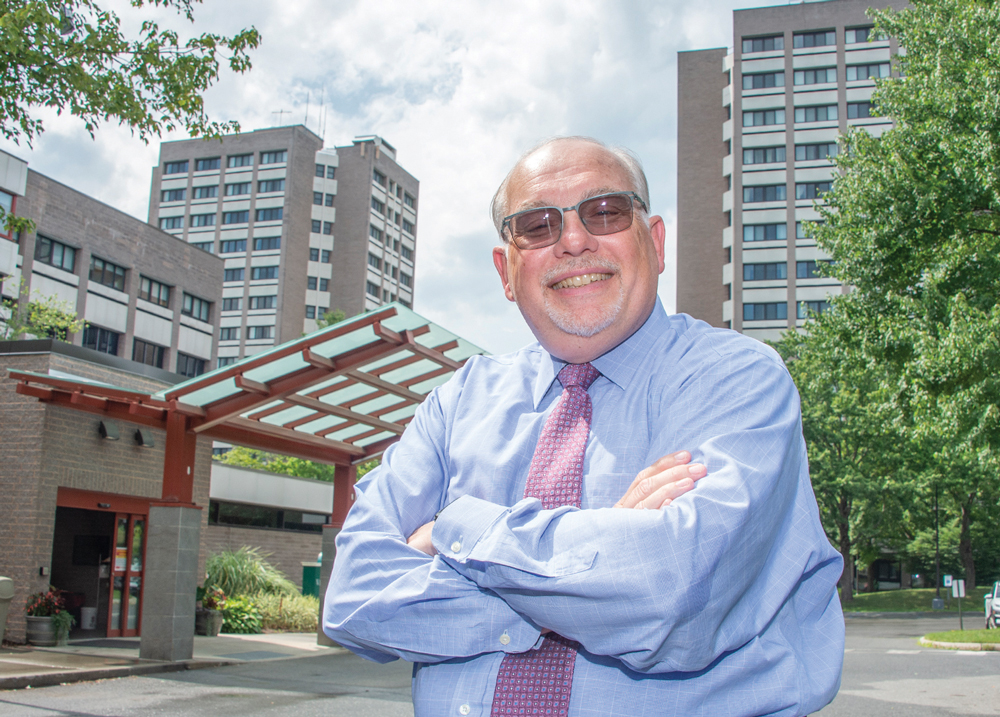
©2022 Saratoga Photographer.com
By Christine Graf
Of the more than one million Americans who have died from COVID-19, a staggering 23 percent were residents of long-term care facilities. According to Brian Nealon, CEO of the Wesley Community, these sobering statistics have impacted the way Americans view nursing homes.
“People are looking to age in place even more so than they did prior to the beginning of the pandemic. It’s about ‘How do I stay at home longer?’ It could be the family home that they have been in for 50 years or it could be at one of our apartments at Woodlawn Commons or Embury.”
Located on Lawrence Street in Saratoga Springs, Woodlawn Commons offers 60 market-rate independent senior living apartments as well as 40 assisted living units. The neighboring Embury Apartments provides the local community with 192 subsidized senior apartments. Both complexes are currently at full capacity.
The Wesley Community also has a skilled nursing facility that provides both long-term care as well as short-term rehabilitation. They also offer home care through Wesley Senior Solutions and outpatient physical/occupational/speech therapy through Wesley Outpatient Therapy.
In total, more than 600 seniors live on the sprawling Wesley Community Campus in the north end of Saratoga Springs.
Nealon has worked for Wesley for 37 years, but nothing could have prepared him to be on the front lines at the height of the pandemic. COVID claimed the lives of hundreds of long-term care facility residents throughout the Capital Region.
“We care for the frailest of the frail, so it’s not unexpected that people passed away at nursing homes because of COVID,” he said. “The press that surrounded that certainly motivated individuals to want to stay out of assisted living or nursing homes.”
When the state mandated that no outside visitors were allowed at nursing homes for an entire year, an already difficult situation became even worse. Many elderly residents died without being able to see their families while others went more than a year without visits from loved ones.
“It was horrific. It was agonizing for families and demoralizing for the residents as well as demoralizing for our staff. It was a very difficult time, and some folks live in fear of that happening again,” said Nealon.
“Generally, as the boomer generation becomes more present in the aging service world, they are looking for services at home and trying to avoid an institutional setting. Boomers are trying hard to set aging services up in a way that provides for the highest level of independence.”
As more boomers seek home care that will allow them to stay in their homes longer, the home care employee shortage will prove problematic.
“Most home care operators have to turn down cases because there isn’t the staff,” said Nealon. “Right now, it’s a struggle, and it’s going to remain a struggle for the next decade plus.”
According to Nealon, “virtual villages” are being established throughout the country to assist seniors who are want to remain in their homes for as long as possible. The concept began in Boston in 2001 when a network of seniors who wanted to stay in their own homes began sharing resources that would help people age in place. Also referred to as elder villages or senior villages, virtual villages are nonprofits that rely primarily on volunteers to provide services to the elderly. There are now more than 400 of these throughout the United States.
Even as aging in place becomes more common, there will always be a need for long-term care facilities. Due to industry-wide staffing shortages, the Wesley Community has already been forced to close two nursing home units with a total of 90 beds.
“It’s not because of a lack of demand,” said Nealon. “We closed one in late 2020, and we closed the second one in the middle of 2021. They aren’t permanently closed, but they are closed for the foreseeable future.”
With fewer nursing home residents, Wesley is able to provide roughly the same hours per resident per day as before the pandemic. Wages were increased last summer and another increase will be occurring in the near future.
“The backbone of any nursing home is the certified nursing assistant (CNA), and right now, that starts at $17 an hour,” said Nealon. “Pre-pandemic it was about $14 an hour.”
Part of the existing labor shortage can be attributed to the health care worker vaccine mandate. Health care facilitates were required to terminate employees who were unwilling to receive the initial vaccine as well as the first booster.
“We lost some with the initial vaccine,” said Nealon. “But when the initial booster was mandated, we lost a larger number with that than we did with the actual original vaccine.”
On a positive note, Nealon noted that the masking requirements that remain in place and have resulted in a significant decline in flu cases.
“We had only a few cases of the flu last year which was remarkable. It was also impressive how few people caught a cold. We are all masked all day long, and it clearly made a difference.”
As Nealon reflects on the challenges of the last two years, he said he is grateful to his staff as well as to members of the local community.
